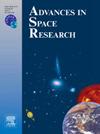Operational insights and measurements of ChaSTE on the Chandrayaan 3 Vikram Lander
IF 2.8
3区 地球科学
Q2 ASTRONOMY & ASTROPHYSICS
引用次数: 0
Abstract
Understanding the thermal properties of lunar regolith is crucial for accurately modelling heat transfer processes, evaluating the thermal behavior of lunar surface and subsurface, predicting volatile escape processes, and planning future exploration missions. Chandra’s Surface Thermophysical Experiment (ChaSTE) is a payload onboard Chandrayaan 3 lander of Indian Space Research Organisation (ISRO), which measured temperature and thermal conductivity of lunar regolith by inserting a thermal probe into the regolith. This study details the timeline of ChaSTE activities on the lunar surface, the penetration operation of the ChaSTE probe into the regolith, and measurements of thermophysical properties such as packing density and thermal conductivity and temperature up to a depth of 10 cm at the landing location (69.37 ° S, 32.32 ° E) on the southern high-latitude region of the Moon. The mission life of ChaSTE was 12 days during August – September, 2023. The measurements performed by ChaSTE are the first of their kind on the high-latitude lunar regolith.
月船3号维克拉姆着陆器上ChaSTE的操作见解和测量
了解月球风化层的热特性对于准确模拟传热过程、评估月球表面和地下的热行为、预测挥发性逸出过程以及规划未来的探测任务至关重要。钱德拉表面热物理实验(ChaSTE)是印度空间研究组织(ISRO)的月船3号着陆器上的有效载荷,通过在月球风化层中插入热探针来测量温度和热导率。本研究详细介绍了ChaSTE在月球表面的活动时间表,ChaSTE探测器对月球表层的渗透操作,以及在月球南部高纬度地区(69.37°S, 32.32°E)着陆位置(深度为~ 10 cm)的热物理性质(如填料密度、热导率和温度)的测量。ChaSTE的任务寿命在2023年8月- 9月为~ 12天。ChaSTE进行的测量是首次在高纬度月球风化层上进行此类测量。
本文章由计算机程序翻译,如有差异,请以英文原文为准。
求助全文
约1分钟内获得全文
求助全文
来源期刊

Advances in Space Research
地学天文-地球科学综合
CiteScore
5.20
自引率
11.50%
发文量
800
审稿时长
5.8 months
期刊介绍:
The COSPAR publication Advances in Space Research (ASR) is an open journal covering all areas of space research including: space studies of the Earth''s surface, meteorology, climate, the Earth-Moon system, planets and small bodies of the solar system, upper atmospheres, ionospheres and magnetospheres of the Earth and planets including reference atmospheres, space plasmas in the solar system, astrophysics from space, materials sciences in space, fundamental physics in space, space debris, space weather, Earth observations of space phenomena, etc.
NB: Please note that manuscripts related to life sciences as related to space are no more accepted for submission to Advances in Space Research. Such manuscripts should now be submitted to the new COSPAR Journal Life Sciences in Space Research (LSSR).
All submissions are reviewed by two scientists in the field. COSPAR is an interdisciplinary scientific organization concerned with the progress of space research on an international scale. Operating under the rules of ICSU, COSPAR ignores political considerations and considers all questions solely from the scientific viewpoint.
 求助内容:
求助内容: 应助结果提醒方式:
应助结果提醒方式:


